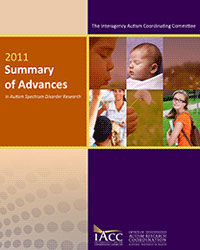Summary of Advances
In Autism Spectrum Disorder Research
2011
A systematic review of medical treatments for children with autism spectrum disorders – McPheeters ML, Warren Z, Sathe N, Bruzek JL, Krishnaswami S, Jerome RN, Veenstra-Vanderweele J. Pediatrics. 2011 May;127(5):e1312-21. [PMID: 21464191]
Researchers conducted a systematic literature review to evaluate the effectiveness of drug treatments for children with autism spectrum disorder, age 12 and younger. While there was strikingly little evidence to support the benefits of most medications prescribed for children with ASD, the antipsychotics risperidone and aripiprazole showed clear benefit for managing challenging and repetitive behavior. Both drugs had at least one randomized controlled trial, considered the gold standard for intervention studies, conducted by the pharmaceutical company that produces each drug and at least two randomized controlled trials showing parent-reported benefits. The strength of the evidence for aripiprazole was considered to be high, while risperidone was deemed moderate. Despite benefits, both drugs cause significant side effects including marked weight gain, sedation, and a number of movement disorders; as a result, they are generally limited to patients with severe impairment or risk of injury. The systematic review also examined antidepressants and stimulants and found insufficient evidence to evaluate the effectiveness of either type of drug in reducing challenging and repetitive behavior in children with ASD. A widespread search across multiple databases identified only one good-quality and one fair-quality randomized controlled trial of serotonin reuptake inhibitors (SRIs) and one good-quality randomized controlled trial of stimulants. Study quality was determined by two reviewers who independently assessed the studies based on factors such as study design, participant characterization, diagnostic approach, outcome measurement, and statistical analysis. The authors note the need for more publicly funded studies to evaluate the potential benefits and risks of medications currently being prescribed for children on the spectrum.
Intervention targeting development of socially synchronous engagement in toddlers with autism spectrum disorder: a randomized controlled trial – Landa RJ, Holman KC, O'Neill AH, Stuart EA. J Child Psychol Psychiatry. 2011 Jan;52(1):13-21. [PMID: 21126245]
Two-year-olds with ASD showed improved social skills after completing an intervention targeting core social deficits in autism. It is the first randomized controlled trial to test such an intervention in toddlers and gives promise that a supplementary curriculum could improve social and communication skills in very young children. The researchers randomly assigned 50 toddlers with ASD, aged 21 to 33 months, to receive either an intervention called Interpersonal Synchrony – which targets social imitation, joint attention skills, and sharing of emotions – or a comparison intervention that does not target these specific social skills. Both six-month interventions were used for 10 hours per week in the classroom, and parents in both groups were given similar levels of training to continue the intervention at home. While toddlers in both groups showed gains in social, cognitive, and language skills during the study, children who received the Interpersonal Synchrony intervention, which encouraged them to communicate and play with others, had the greatest progress. At the end of the six months, these children had more than doubled the instances in which they engaged in social imitation (such as imitating the way a parent plays with a toy or mimicking a facial expression), while also making eye contact. Social imitation is believed to be critical in developing social communication skills – deficits in such core social skills are a defining characteristic of autism. Importantly, children in the Interpersonal Synchrony group were able to generalize their newly developed skills to new people and settings. While their progress slowed in the six months following the end of the intervention, they did not lose any of the skills gained, unlike children in the comparison group who showed poorer social communication skills at the six-month follow-up.
Randomized, controlled trial of the LEAP model of early intervention for young children with autism spectrum disorders – Strain PS and Bovey EH. Topics in Early Childhood Special Education. 2011 Nov;31(3):133-154. [Link]
A 2011 study supports the effectiveness of an early intervention model for autism spectrum disorder designed to be used in an integrated classroom. Randomized controlled trials are considered to be the gold standard of evidence; however, due to their complexity and cost, only four other RCTs of comprehensive interventions for young children with autism had been completed at the time this article was published. Of these four, all were tested in segregated environments and involved one-on-one instruction at the beginning of the intervention. In contrast, the LEAP (Learning Experiences and Alternative Program for Preschoolers and Their Parents) preschool model uses teaching opportunities that arise naturally in an integrated setting and incorporates typically developing students by training them to support the social skills development of their peers with ASD. The LEAP model is also the first evidence-based intervention for ASD to be tested in a public school setting. In the study, researchers compared the performance of students in 28 classrooms where teachers received personal training and coaching support in the LEAP model over two years to the performance of teachers in 28 classrooms who received only training manuals and written materials. While all children had equivalent skill levels at the start of the intervention, after two years the students in the coached classrooms showed marked improvement in symptoms of autism, cognitive scores, language development, social skills, and a reduction in problem behavior. The teachers' fidelity to the LEAP strategies predicted the students' level of improvement. These findings suggest that successfully adhering to LEAP strategies produces broad developmental improvements. It costs much less than other commonly used one-on-one strategies – an estimated $20,000 per child annually compared to $45,000 – $69,000.




